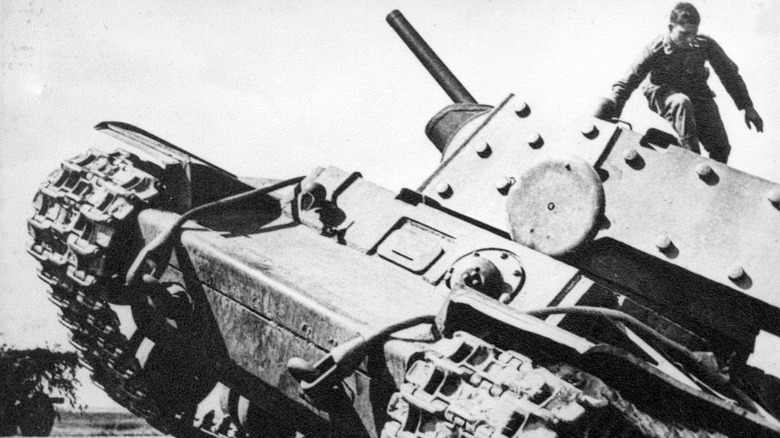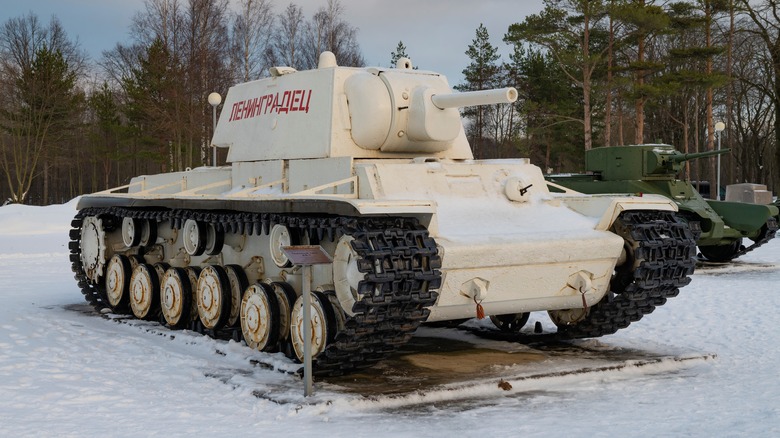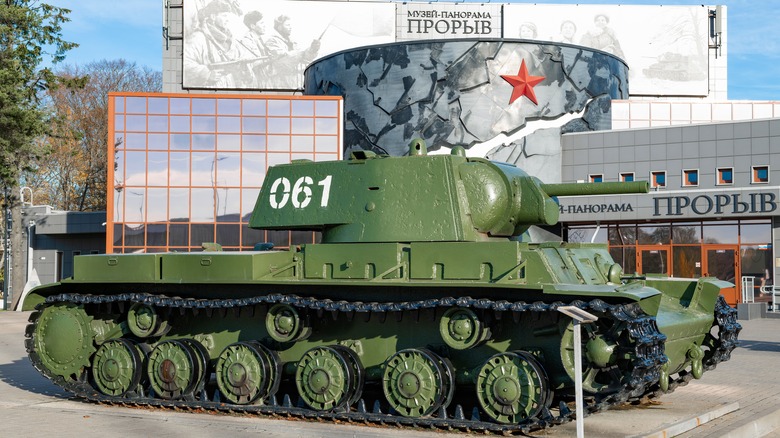What Made The KV-1 Heavy Tank Such A Behemoth On The Battlefield
Heavy tanks, despite what their designation may suggest, weren't simply designed to be great, lumbering hulks. Thick armor to absorb punishment was paramount, certainly, but so too was relative mobility. This is where the Soviet Union's Object 279, an enormous, magnificent and ultimately impractical machine, rather fell down.
Technological advances over the developmental history of the tank were crucial. They meant that medium tanks and later MBTs could wield fearsome, heavy armaments while still being more maneuverable. After all, their armor could be as thick as possible, but it was just extra weight against new weapons designed to penetrate it. Before the era of the heavy tank was over, though, it brought the world some of the most intimidating and powerful ground vehicles ever. Another Soviet Union creation, the KV-1, was a prime example of this.
During World War II, the Soviet Union had a predilection for the mightiest of machines. As retired Chief Warrant Officer 2 Stephen L. "Cookie" Sewell wrote in Armor magazine in 2002, a cornerstone of the armored strategy was "very heavy tanks used for breaking through into the enemy's rear areas." Few vehicles have ever defined this concept quite like the KV-1. Let's see how this awe-inspiring machine was developed, and explore its impact in combat.
Operation Barbarossa and the KV-1
The Soviet heavy tanks would face the staunchest test later in the war: the German invasion of the Soviet Union, Operation Barbarossa, which began in June 1941.
By this stage in the conflict, Germany had overwhelmed nations of Europe in short order with devastating rushes, its deadly tanks at the fore. Adolf Hitler and his generals believed that victory here could be achieved by that October. However, this didn't take into account formidable Soviet tanks like the KV-1.
The KV-1 had been developed the year before, after a Main Military Council meeting of 1938. Here, the Soviets planned a heavy tank more powerful yet more practical than any in their roster, building upon the T-28 and foregoing the extra guns they had originally planned to add. The KV-1 that resulted was a vehicle to behold indeed.
The KV-1 was equipped with a 76 mm cannon that weighed a mighty 47.5 tons, and its armor was 75 mm thick. Its German opposition at the time struggled against it. In "When Titans Clash," David M. Glantz notes that Mark III and Mark IV tanks wielded 50mm and 75mm guns in 1941, and that "neither German weapon could penetrate the thick frontal armor of the T-34 medium tanks and KV-1 heavy tanks." The latter took this concept to the extremes, and its gun was strong enough to destroy any opposing armor in return.
A beast of a vehicle on the attack and the defense
It may sound as though the KV-1 was an almost perfect weapon, and there's absolutely no denying that it was incredibly potent. It didn't remain so for long, however. It was very difficult to destroy one in 1941, but it wasn't always necessary to do so. They were very unreliable, and maintenance was a logistical headache for the Soviets. On top of that, the first run of around 2,300 KV-1s were equipped with "a 1920's U.S. tractor transmission and an overstressed engine" according to Armor. These were very awkward to steer and operate.
An improved model, the KV-1S, reduced the weight and improved the components of the machine, while retaining its defensive capabilities. Around 2,400 of them were introduced, but by the time of their arrival, the German army had its own upgraded tanks. Later in 1942, the Tiger tank was establishing itself, and it was capable of cutting through even the KV-1S's defenses.
In short, the KV-1 was the ultimate (if highly flawed) defensive force for a brief period of time. It would go the way of all dedicated heavy (with a capital H) tanks in the end, but it continues to serve as a gigantic time capsule of military technology and attitudes.


